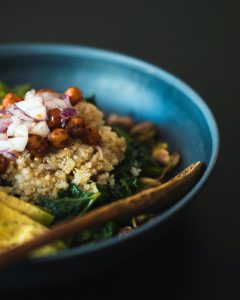
- Readers Rating
- No Rating Yet!
- Your Rating
Have you ever considered giving up your carnivorous diet to help the environment but haven’t dared to start? Would you like to contribute to the cause but don’t know how? Nowadays, there are many diet alternatives to reduce meat consumption; however, from the outside, they seem very rigid in terms of rules. Many people have chosen to join the cause in a flexible way, that is, by significantly reducing their meat consumption without giving up these products entirely. It’s a modern way to contribute to sustainability and prevent animal cruelty without having to give up certain foods for life. In this Mentta blog, we’ll explain what the flexitarian diet is.
What is the flexitarian diet?
The flexitarian diet is an eating approach that combines the words “flexible” and “vegetarian,” reflecting its essence: a primarily vegetarian diet that occasionally allows the consumption of animal products. This flexibility makes it accessible and appealing to those who want to reduce their meat intake without giving it up entirely. It is based on the principle of increasing the consumption of plant-based foods while decreasing meat and other animal products, thereby promoting a healthier and more sustainable diet.

Origin and Evolution of the Flexitarian Diet
The idea of reducing meat consumption is not new, but the term “flexitarian” began to gain popularity in the 1990s and early 2000s. Dawn Jackson Blatner, a registered dietitian and author, was one of the main advocates of this lifestyle with her book The Flexitarian Diet published in 2009. Blatner promoted a mostly vegetarian diet with the flexibility to include meat occasionally, thus adapting to the preferences and lifestyles of more people.
Over the past two decades, concerns about health, animal welfare, and the environment have driven the adoption of more plant-based diets. Studies have shown that diets rich in plant-based foods can reduce the risk of chronic diseases such as type 2 diabetes, heart disease, and certain types of cancer. Additionally, the environmental impact of meat production has led many to seek more sustainable alternatives.
Guidelines for Following a Flexitarian Diet
Adopting a flexitarian diet doesn’t simply mean eating less meat. It requires a conscious and balanced approach to ensure adequate nutrition and a smooth transition to increased consumption of plant-based foods. Here are some key guidelines for following a flexitarian diet:
- Increase fruit and vegetable intake: The foundation of the flexitarian diet is fresh fruits and vegetables. These foods are rich in vitamins, minerals, antioxidants, and fiber, all essential for good health.
- Incorporate plant-based proteins: Replace animal proteins with plant-based alternatives like legumes, tofu, tempeh, nuts, and seeds. These foods provide not only protein but also other important nutrients like iron and zinc.
- Opt for whole grains: Choose whole grains such as quinoa, brown rice, oats, and barley over refined grains. Whole grains are an important source of fiber and other nutrients.
- Consume dairy and eggs in moderation: Dairy products and eggs can be part of the flexitarian diet, but it’s recommended to choose low-fat versions and consume them in moderation.
- Reduce red and processed meat consumption: Red and processed meats should be limited due to their links to chronic diseases. Instead, when consuming meat, opt for poultry, fish, and seafood, which are healthier options.
- Incorporate whole and minimally processed foods: Prioritize whole foods and avoid highly processed ones, which often contain unhealthy additives, sugars, and fats.
- Plan meals: Planning and preparing meals in advance can help ensure a balanced and varied diet. Include a variety of colors and textures in your dishes to maintain interest and nutrition.
- Stay hydrated: Drinking enough water is essential for overall health. Herbal teas and fruit-infused water can also be refreshing and healthy options.
Benefits of the Flexitarian Diet
The flexitarian diet offers numerous health and environmental benefits:
- Improves heart health: Diets rich in plant-based foods are associated with lower cholesterol and blood pressure levels, reducing the risk of heart disease.
- Promotes weight loss: By focusing on low-calorie, nutrient-rich foods, the flexitarian diet can help with weight loss and maintenance.
- Reduces the risk of type 2 diabetes: Studies have shown that plant-based diets can improve insulin sensitivity and reduce the risk of type 2 diabetes.
- Increases longevity: A higher intake of fruits, vegetables, and whole grains, along with reduced processed meat consumption, is associated with a longer life expectancy.
- Benefits the environment: Plant-based food production generally requires fewer resources and produces fewer greenhouse gas emissions than meat production, helping to reduce the ecological footprint.
- Improves digestion: The high fiber intake from fruits, vegetables, and whole grains promotes healthy digestion and prevents constipation.
Mini Flexitarian Recipe: Quinoa Salad with Chickpeas and Vegetables
Ingredients:
- 1 cup quinoa
- 1 ½ cups water
- 1 can chickpeas (400g), drained and rinsed
- 1 red bell pepper, diced
- 1 cucumber, diced
- 1 carrot, grated
- ½ cup cherry tomatoes, halved
- ¼ cup red onion, chopped
- 2 tablespoons fresh parsley, chopped
- 2 tablespoons lemon juice
- 2 tablespoons olive oil
- Salt and pepper to taste

Instructions:
- Rinse the quinoa under cold water and place it in a pot with 1 ½ cups of water. Bring to a boil, reduce the heat, and simmer for 15 minutes or until the water is absorbed and the quinoa is cooked. Let it cool.
- In a large bowl, mix the cooked quinoa with the chickpeas, red bell pepper, cucumber, carrot, cherry tomatoes, and red onion.
- In a small bowl, whisk together the lemon juice, olive oil, salt, and pepper.
- Pour the dressing over the salad and mix well.
- Sprinkle with chopped fresh parsley before serving.
This salad is a perfect example of a flexitarian dish: rich in plant-based proteins, fiber, vitamins, and minerals, and completely delicious.
The flexitarian diet represents an accessible and balanced option for those who want to improve their health and contribute to the planet’s well-being without entirely giving up animal products. By focusing on a variety of plant-based foods and allowing the flexibility to include meat occasionally, this diet can be adapted to different lifestyles and dietary preferences. With its numerous health and environmental benefits, the flexitarian diet is an excellent choice for those seeking a more conscious and healthy approach to eating.
Learn more about gastronomy on the mentta blog.
